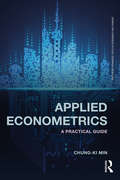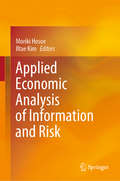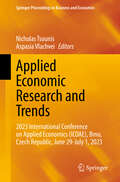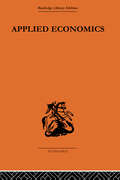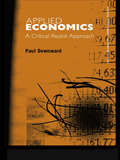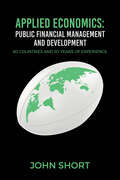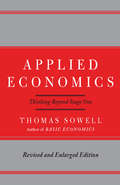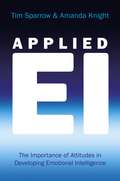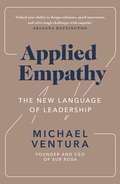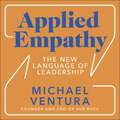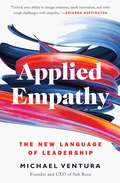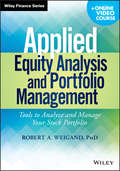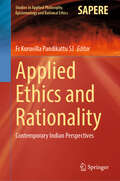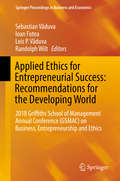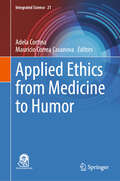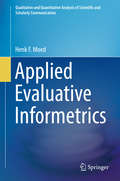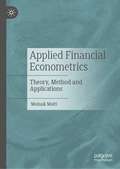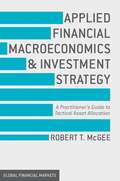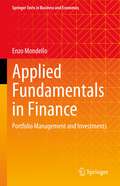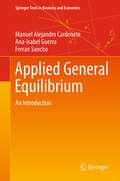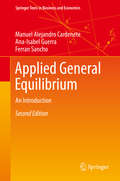- Table View
- List View
Applied Econometrics: A Practical Guide (Routledge Advanced Texts in Economics and Finance)
by Chung-ki MinApplied Econometrics: A Practical Guide is an extremely user-friendly and application-focused book on econometrics. Unlike many econometrics textbooks which are heavily theoretical on abstractions, this book is perfect for beginners and promises simplicity and practicality to the understanding of econometric models. Written in an easy-to-read manner, the book begins with hypothesis testing and moves forth to simple and multiple regression models. It also includes advanced topics: Endogeneity and Two-stage Least Squares Simultaneous Equations Models Panel Data Models Qualitative and Limited Dependent Variable Models Vector Autoregressive (VAR) Models Autocorrelation and ARCH/GARCH Models Unit Root and Cointegration The book also illustrates the use of computer software (EViews, SAS and R) for economic estimating and modeling. Its practical applications make the book an instrumental, go-to guide for solid foundation in the fundamentals of econometrics. In addition, this book includes excerpts from relevant articles published in top-tier academic journals. This integration of published articles helps the readers to understand how econometric models are applied to real-world use cases.
Applied Economic Analysis of Information and Risk
by Moriki Hosoe Iltae KimThis book examines interesting new topics in applied economics from the perspectives of the economics of information and risk, two fields of economics that address the consequences of asymmetric information, environmental risk and uncertainty for the nature and efficiency of interactions between individuals and organizations. In the economics of information, the essential task is to examine the condition of asymmetric information under which the information gap is exploited. For the economics of risk, it is important to investigate types of behavior including risk aversion, risk sharing, and risk prevention, and to reexamine the classical expected utility approach and the relationships among several types of the changes in risk. Few books have ever analyzed topics in applied economics with regard to information and risk. This book provides a comprehensive collection of applied analyses, while also revisiting certain basic concepts in the economics of information and risk. The book consists of two parts. In Part I, several aspects of applied economics are investigated, including public policy, labor economics, and political economics, from the standpoint of the economics of (asymmetric) information. First, several basic frameworks of the incentive mechanism with regard to transaction-specific investment are assessed, then various tools for market design and organization design are explored. In Part II, mathematical measures of risk and risk aversion are examined in more detail, and readers are introduced to stochastic selection rules governing choice behavior under uncertainty. Several types of change in the random variable for the cumulative distribution function (CDF) and probability distribution function (PDF) are discussed. In closing, the part investigates the comparative static results of these changes in CDF or PDF on the general decision model, incorporating uncertain situations in applied economics.
Applied Economic Research and Trends: 2023 International Conference on Applied Economics (ICOAE), Brno, Czech Republic, June 29-July 1, 2023 (Springer Proceedings in Business and Economics)
by Nicholas Tsounis Aspasia VlachveiThis volume presents new research and trends in applied economic research with special interest in advances in applied macroeconomics, microeconomics, financial economics, international economics, agricultural economics, health economics, marketing, and management. It features contributions presented at the 2023 International Conference on Applied Economics (ICOAE) held in Brno, Czech, Republic including country specific studies from 40 different countries. The contents of this volume is of interest to researchers, scholars, academics and policy makers within applied economics.
Applied Economics (Routledge Studies In Defence Economics Ser.)
by A. J. BrownAmong the issues discussed in Applied Economics are world population growth and the economic factors governing international migration: issues that are as pertinent today as when the book was originally published.The problems of defining and comparing industrial and general efficiency in different economies are also discussed, using comparative studies from the UK and USA. The opportunities for analysing the pattern of world trade and the reasons for the varying degrees of national dependence on external trade, as well as the concentration of world export in particular channels are also examined.
Applied Economics and the Critical Realist Critique (Routledge INEM Advances in Economic Methodology)
by Paul DownwardThis intriguing new book examines and analyses the role of critical realism in economics and specifically how this line of thought can be applied to the real world. With contributions from such varying commentators as Sheila Dow, Wendy Olsen and Fred Lee, this new book is unique in its approach and will be of great interest to both economic methodologists and those involved in applied economic studies.
Applied Economics in the Digital Era: Essays in Honor of Gary Madden
by James Alleman Paul N. Rappoport Mohsen HamoudiaGary Madden was a renaissance man with respect to the nexus between information and communications technology (ICT) and economics. He contributed to a variety of fields in ICT: applied econometrics, forecasting, internet governance and policy. This series of essays, two of which were co-authored by Professor Madden prior to his untimely death, cover the range of his research interests. While the essays focus on a number of ICT issues, they are on the frontier of research in the sector. Gerard Faulhaber provides a broad overview of how we have reached the digital age and its implications. The applied econometric section brings the latest research in the area, for example Lester Taylor illustrates how own-price, cross-price and income elasticities can be calculated from survey data and translated into real income effects. The forecasting section ranges from forecasting online political participation to broadband’s impact on economic growth. The final section covers aspects of governance and regulation of the ICT sector.
Applied Economics: 60 countries and 50 years of experience
by John ShortApplied Economics: Public Financial Management and Development is focused on economics applied to public financial management and development. It charts over 50 years of the author’s practical experience of economics and public policy in 60 countries on five continents, from Afghanistan to Zimbabwe. The book’s main focal point is on central and local government budgeting, tracing the progress of revenue aspects and expenditure allocation over time from inputs alone to matching these inputs to achieving and measuring service delivery in programmes. It also presents the assessment instruments that measure public financial management strength and weakness, with real-life illustrations of their application. All of these instruments use examples from the countries that the author has worked in, demonstrating the conditions faced – mostly stable economic environments, but at times during periods of conflict and insecurity, as well as neighbouring geopolitical tension.These experiences have been gained from the author’s resident assignments and short-term visits (mainly multiple over many years) as a consultant for the IMF, World Bank, and bilateral development programmes as well as academic research.
Applied Economics: Thinking Beyond Stage One
by SowellThis revised edition of Applied Economics is about fifty percent larger than the first edition. It now includes a chapter on the economics of immigration and new sections of other chapters on such topics as the "creative" financing of home-buying that led to the current "subprime" mortgage crisis, the economics of organ transplants, and the political and economic incentives that lead to money earmarked for highways being diverted to mass transit and to a general neglect of infrastructure. On these and other topics, its examples are drawn from around the world. Much material in the first edition has been updated and supplemented. The revised and enlarged edition of Applied Economics retains the easy readability of the first edition, even for people with no prior knowledge of economics.
Applied Emotional Intelligence
by Tim Knight Amanda SparrowA decade on from its birth, emotional intelligence is attracting more attention than ever before. Why? Because of its proven connection to performance. Tomorrow's leaders will have to be facilitators who work collaboratively to help others develop their potential, and this will require emotionally intelligent skills and attitudes. Against this landscape, Applied EI provides the tools and advice needed to develop and manage a relationship with yourself and create positive relationships with others - the twin cornerstones of emotional intelligence. We're all capable of acting with emotional intelligence. Most of us don't, because internal interferences - misguided beliefs and attitudes learnt in childhood - get in the way. Countering this, Applied EI attaches unique importance to the role of attitudes in developing and applying emotional intelligence. Tim Sparrow and Amanda Knight stress that EI isn't a synonym for personality; it's about managing personality. That's why knowing how to put EI into practice is essential. And that's why reducing EI to a single number or score misses the point, and serves only to give us another measure by which to judge ourselves and others. Anyone interested in performance improvement today needs to be interested in emotional intelligence. Applied EI shows how our attitudes underpin our EI, explores how to develop emotionally intelligence attitudes, and lays out tactics for applying them in practice. It discusses what is needed at individual, team and leadership development levels, and considers what it means to be an EI practitioner. Its practical approach and unique perspective make it a must-read for anyone involved in the field of personal development.
Applied Empathy: The New Language of Leadership
by Michael VenturaMichael Ventura, entrepreneur and CEO of award-winning strategy and design practice Sub Rosa, shares how empathy - the ability to see the world through someone else's eyes - could be what your business needs to innovate, connect, and grow.Having built his career working with iconic brands and institutions such as Google and Nike, and also The United Nations and the Obama Administration, Michael Ventura offers entrepreneurs and executives a radical new business book and way forward.Empathy is not about being nice. It's not about pity or sympathy either. It's about understanding - your consumers, your colleagues, and yourself - and it's a direct path to powerful leadership. As such, Applied Empathy presents real strategies on how to make lasting connections and evolve your business internally as well as externally.This ground-breaking guide lays the foundation to establish a diverse, inventive, and driven team that can meet the challenges of today's ever-evolving marketplace. If you want to connect to the people you work with and for, you first have to understand them.
Applied Empathy: The New Language of Leadership
by Michael Ventura'How to unlock our ability to design solutions, spark innovation, and solve tough challenges with empathy at the centre' - Arianna HuffingtonMichael Ventura, entrepreneur and CEO of award-winning strategy and design practice Sub Rosa, shares how empathy - the ability to see the world through someone else's eyes - could be what your business needs to innovate, connect, and grow.Having built his career working with iconic brands and institutions such as Google and Nike, and also The United Nations and the Obama Administration, Michael Ventura offers entrepreneurs and executives a radical new business book and way forward.Empathy is not about being nice. It's not about pity or sympathy either. It's about understanding - your consumers, your colleagues, and yourself - and it's a direct path to powerful leadership. As such, Applied Empathy presents real strategies on how to make lasting connections and evolve your business internally as well as externally.This ground-breaking guide lays the foundation to establish a diverse, inventive, and driven team that can meet the challenges of today's ever-evolving marketplace. If you want to connect to the people you work with and for, you first have to understand them.(P)2018 Simon & Schuster
Applied Empathy: The New Language of Leadership
by Michael VenturaMichael Ventura, entrepreneur and CEO of award-winning strategy and design firm Sub Rosa, shares &“how to unlock our ability to design solutions, spark innovation, and solve tough challenges with empathy at the center&” (Arianna Huffington). Having built his career working with iconic brands and institutions such as General Electric, Google, Nike, Warby Parker, and also The United Nations and the Obama Administration, Michael Ventura offers entrepreneurs and executives a radical new business book and way forward. Empathy is not about being nice. It&’s not about pity or sympathy either. It&’s about understanding—your consumers, your colleagues, and yourself—and it&’s a direct path to powerful leadership. As such, Applied Empathy presents real strategies, based on Sub Rosa&’s design work and the popular class Ventura and his team have taught at Princeton University, on how to make lasting connections and evolve your business internally (your employees, culture, and product/services) as well as externally (your brand, consumers, and value). &“The most neglected fact in business is we&’re all human. Michael Ventura makes a powerful argument that empathy is the secret sauce of 21st century business. The more digital we get, the more empathy we need&” (Chip Conley, New York Times bestselling author of Emotional Equation). For leaders of all levels, this groundbreaking guide lays the foundation to establish a diverse, inventive, and driven team that can meet the challenges of today&’s ever-evolving marketplace. If you want to connect to the people you work with, you have to understand them first.
Applied Environmental Biotechnology: Present Scenario And Future Trends
by Garima KaushikApplied Environmental Biotechnology: Present Scenario and Future Trends is designed to serve as a reference book for students and researchers working in the area of applied environmental science. It presents various applications of environmental studies that involve the use of living organisms, bioprocesses engineering technology, and other fields in solving environmental problems like waste and waste waters. It includes not only the pure biological sciences such as genetics, microbiology, biochemistry and chemistry but also from outside the sphere of biology such as chemical engineering, bioprocess engineering, information technology, and biophysics. Starting with the fundamentals of bioremediation, the book introduces various environmental applications such as bioremediation, phytoremediation, microbial diversity in conservation and exploration, in-silico approach to study the regulatory mechanisms and pathways of industrially important microorganisms biological phosphorous removal, ameliorative approaches for management of chromium phytotoxicity, sustainable production of biofuels from microalgae using a biorefinery approach, bioelectrochemical systems (BES) for microbial electroremediation and oil spill remediation. The book has been designed to serve as comprehensive environmental biotechnology textbooks as well as wide-ranging reference books. Environmental remediation, pollution control, detection and monitoring are evaluated considering the achievement as well as the perspectives in the development of environmental biotechnology. Various relevant articles are chosen up to illustrate the main areas of environmental biotechnology: industrial waste water treatment, soil treatment, oil remediation, phytoremediation, microbial electro remediation and development of biofuels dealing with microbial and process engineering aspects. The distinct role of environmental biotechnology in future is emphasized considering the opportunities to contribute with new approached and directions in remediation of contaminated environment, minimising waste releases and development pollution prevention alternatives at before and end of pipe.
Applied Equity Analysis and Portfolio Management: Tools to Analyze and Manage Your Stock Portfolio (Wiley Finance)
by Robert A. WeigandA "hands-on" guide to applied equity analysis and portfolio management From asset allocation to modeling the intrinsic value of a stock, Applied Equity Analysis and Portfolio Management + Online Video Course offers readers a solid foundation in the practice of fundamental analysis using the same tools and techniques as professional investors. Filled with real-world illustrations and hands-on applications, Professor Weigand's learning system takes a rigorous, empirical approach to topics such as analyzing the macro-finance environment, sector rotation, financial analysis and valuation, assessing a company's competitive position, and reporting the performance of a stock portfolio. Unlike typical books on this subject—which feature chapters to read and exercises to complete—this resource allows readers to actively participate in the learning experience by completing writing exercises and manipulating interactive spreadsheets that illustrate the principles being taught. The learning system also features instructional videos that demonstrate how to use the spreadsheet models and excerpts from the author's blog, which are used to depict additional examples of the analysis process. Along the way, it skillfully outlines an effective approach to creating and interpreting outputs typically associated with a top-down money management shop — including a macroeconomic forecasting newsletter, detailed stock research reports, and a portfolio performance attribution analysis. Covers topics including active and passive money management, fundamental analysis and portfolio attribution analysis Companion streaming videos show how to use free online data to create yourown analyses of key economic indicators, individual stocks, and stock portfolios A valuable resource for universities who have applied equity analysis and portfolio management courses Practical and up-to-date, the book is an excellent resource for those with a need for practical investment expertise.
Applied Ethics and Rationality: Contemporary Indian Perspectives (Studies in Applied Philosophy, Epistemology and Rational Ethics #74)
by Fr Kuruvilla Pandikattu SJThis book provides an in-depth exploration of ethics and rationality in the context of the contemporary Indian perspectives, focusing on applied ethics in organizational, technological, environmental, and philosophical contexts. It addresses the urgent need for ethical frameworks in our rapidly evolving world, offering insights and practical solutions grounded in Indian philosophical traditions. It covers organizational ethics, where the role of ethical practices in fostering academic excellence, employee well-being, and inclusive leadership is examined. Corporate social responsibility and environmental ethics are discussed through case studies on renewable energy, climate change disclosures, and sustainable business practices, emphasizing the importance of ethical corporate governance.
Applied Ethics for Entrepreneurial Success: 2018 Griffiths School of Management Annual Conference (GSMAC) on Business, Entrepreneurship and Ethics (Springer Proceedings in Business and Economics)
by Sebastian Văduva Randolph Wilt Ioan Fotea Lois P. VăduvaThis proceedings volume examines the impact of ethics on business and entrepreneurship predominantly from the Romanian perspective. Featuring selected contributions from the 2018 Griffiths School of Management Annual Conference (GMSAC) on Business, Entrepreneurship and Ethics, this book investigates the impact of different social phenomena have upon the understanding and applicability of entrepreneurship and ethics, providing lessons for emerging economies. In emerging economies, entrepreneurship is often times associated with a negative image and entrepreneurs are seen in an unfavorable light. This is due in part to the fact that from a superficial perspective, entrepreneurial behavior does not always amalgamate well with ethical behavior. Entrepreneurship is often perceived as “success at all costs” with little regard to the interest of stakeholder and, sometimes, even the law. On the other hand, ethics are often viewed as metaphysical, having little to do with business, organizational and financial success. In actuality, ethical decisions are a significant part of an organization and ethical behaviors impact organizational culture. Beyond the moral aspects associated with business ethics, companies that practice ethical demeanor are more profitable because investors, employees and consumers seek out companies that engage in fair practices. Featuring contributions on topics such as medical ethics, business education, consumer behavior and governance, this book provides invaluable research and tools for students, professors, practitioners and policy makers in the field s of business, management, public administration and sociology.
Applied Ethics from Medicine to Humor (Integrated Science #21)
by Adela Cortina Mauricio Correa CasanovaApplied ethics is an essential part of practical knowledge in pluralistic and democratic societies. Its fundamental characteristic does not consist only in reflecting on the new moral realities of modern life, but also in guiding the deliberation and freedom of moral agents, people and institutions. This book comprises works on applied ethics by specialists from Spain and Chile. Some topics are well known for their extensive development and dissemination, such as biomedicine, country development, ecology, economics, enterprise and business, and professions. Others themes are presented with the novelty of current debates, such as neuroethics, sports, humor and the city. This book offers a broad look at each topic, and simultaneously provides a moral compass that ethically guides professors and researchers, students and professionals, in order to empower their activities and institutions.
Applied Evaluative Informetrics (Qualitative and Quantitative Analysis of Scientific and Scholarly Communication)
by Henk F. MoedThis book focuses on applied evaluative informetric artifacts or topics. It explains the base notions and assumptions of evaluative informetrics by discussing a series of important applications. The structure of the book is therefore not organized by methodological characteristics, but is centered around popular, often discussed or used informetric artifacts - indicators, methodologies, products, databases - or so called hot topics in which informetric indicators play an important role. Most of the artifacts and topics emerged during the past decade. The principal aims of the book is to present a state of the art in applied evaluative informetrics, and to inform the readers about the pros and cons, potentialities and limitations of the use of informetric/bibliometric indicators in research assessment. The book is a continuation of the book Citation Analysis in Research Evaluation (Springer, 2005). It is of interest to non-specialists, especially research students at advanced master level and higher, all those subjected to quantitative research assessment, research managers and other users of applied informetric techniques, and interested scholars from all domains of science and scholarship.
Applied Financial Econometrics: Theory, Method and Applications
by Moinak MaitiThis textbook gives students an approachable, down to earth resource for the study of financial econometrics. While the subject can be intimidating, primarily due to the mathematics and modelling involved, it is rewarding for students of finance and can be taught and learned in a straightforward way. This book, going from basics to high level concepts, offers knowledge of econometrics that is intended to be used with confidence in the real world. This book will be beneficial for both students and tutors who are associated with econometrics subjects at any level.
Applied Financial Macroeconomics and Investment Strategy
by Robert T. McgeeThe absolute and relative performance of various asset classes is systematically related to macroeconomic trends. In this new book, Robert McGee provides a thorough guide to each stage of the business cycle and analyzes the investment implications using real-world examples linking economic dynamics to investment results.
Applied Fundamentals in Finance: Portfolio Management and Investments (Springer Texts in Business and Economics)
by Enzo MondelloThis textbook provides a comprehensive introduction to portfolio management and investments. Focusing on four core areas – portfolio management, equities, bonds, and derivatives – it is primarily intended for undergraduate and graduate students alike. However, it will also benefit practitioners working in the fields of financial analysis and portfolio management and professionals who aspire to such professional activities in the financial industry. To ensure its high practical relevance, the book includes a host of case studies and examples from real-world practice, mainly from the German and Swiss financial markets. Additionally, the book shows how to implement the models in Microsoft Excel.
Applied Game Theory and Strategic Behavior
by Patrick L. Anderson Ilhan K. GeckilUseful Tools to Help Solve Decision Making ProblemsApplied Game Theory and Strategic Behavior demonstrates the use of various game theory techniques to address practical business, economic, legal, and public policy issues. It also illustrates the benefits of employing strategic thinking that incorporates the uncertainty surrounding the behavior of
Applied General Equilibrium Analysis of India's Tax and Trade Policy (Routledge Revivals)
by Sameer R. RegeThis title was first published in 2003. India's tax revenues depend on manufacturing while agriculture and services generate employment. WTO's Uruguay and Doha rounds imply large tariff cuts. This affects the competitiveness of the Indian manufacturing sector and has implications for government deficits. Excessive dependence on indirect taxes and subsidies to regulate markets introduces distortions and is incompatible with free market principles. The book analyses welfare implications of fiscal and trade policies for India. To put the results in perspective, developments in trade theory, public finance and Computable General Equilibrium (CGE) modelling are covered. Theoretical results are juxtaposed with empirical findings from these models. Methodology to construct CGE models is also covered. The trade model covers tariff cuts under various assumptions besides incorporating "new trade theory". As tax reforms and tariff cuts are independent, past tax reforms like MODVAT (MODified VAT) and proposed reforms like VAT, elimination/reduction of subsidies are covered using a separate tax model.
Applied General Equilibrium: An Introduction (Springer Texts in Business and Economics)
by Ana-Isabel Guerra Ferran Sancho Manuel Alejandro CardeneteThis advanced textbook aims at providing a simple but fully operational introduction to applied general equilibrium. General equilibrium is the backbone of modern economic analysis and as such generation after generation of economics students are introduced to it. As an analytical tool in economics, general equilibrium provides one of the most complete views of an economy since it incorporates all economic agents (households, firms, government, foreign sector) in an integrated way that is compatible with microtheory and microdata. The integration of theory and data handling is required for successful modeling but it requires a double ability that is not found in standard books. With this book we aim at filling the gap and provide advanced students with the required tools, from the building of consistent and applicable general equilibrium models to the interpretation of the results that ensue from the adoption of policies. The topics include: model design, model development, computer code examples, calibration and data adjustments, practical policy examples.
Applied General Equilibrium: An Introduction (Springer Texts in Business and Economics)
by Ana-Isabel Guerra Ferran Sancho Manuel Alejandro CardeneteThis advanced textbook provides a straightforward but comprehensive introduction to applied general equilibrium modeling. General equilibrium is the backbone of modern economic analysis, which is why generation after generation of economics students have been introduced to it. As an analytical tool, general equilibrium can provide one of the most complete views of a given economy, as it incorporates all economic agents (households, firms, government and the foreign sector) in an integrated way that explicitly reveals the interplay of economic forces--supply and demand--and the balancing role of prices. Applied general equilibrium goes one step further in modeling, since it entails the integration of microeconomic theory, data handling and computing. This integration is essential for successful empirical modeling, but also involves various abilities that are not found in standard books. This book fills the gap, providing advanced students with the required tools, from the construction of consistent and applicable general equilibrium models to the interpretation of the results that ensue from the adoption of policies. This second edition expands the range of topics covered, including: indispensable general equilibrium theory, step-by-step model design, incremental model extensions, a wealth of sample computer code, procedures for constructing economic databases, database adjustments and database updating algorithms, numerical model calibration, policy strategies and their trade-offs and welfare effects, and a discussion of empirical policy examples.
